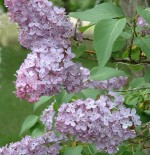 Few plants evoke nostalgia and fond memories more than the common lilac with its heavy trusses of very fragrant flowers. This deciduous shrub is native to southeastern Europe where it grows in open woodlands and scrubby areas and is a member of the olive family, Oleaceae, that also includes jasmine, privet, and forsythia. It grows up to 20′ tall and has dark green heart-shaped leaves on the upper part of the bush that are attractive in spring and summer but do not produce good fall color. In mid to late spring 6-8″ long pyramidal to conical clusters of flowers appear for a short bloom time. Each tubular flower is 1/3″ long, lilac to purple and attractive to bees, butterflies and birds. Cultivars have been introduced that have double flowers and extend the color range to white, rose, and magenta. Lilacs are effective used as specimen plants, in small groups, and as part of a shrub border. The genus name, Syringa, is from the Greek word syrinx meaning pipe and refers to the stem which has a soft pith and can be hallowed out. The specific epithet, vulgaris, is the Latin word meaning common/commonplace.
Few plants evoke nostalgia and fond memories more than the common lilac with its heavy trusses of very fragrant flowers. This deciduous shrub is native to southeastern Europe where it grows in open woodlands and scrubby areas and is a member of the olive family, Oleaceae, that also includes jasmine, privet, and forsythia. It grows up to 20′ tall and has dark green heart-shaped leaves on the upper part of the bush that are attractive in spring and summer but do not produce good fall color. In mid to late spring 6-8″ long pyramidal to conical clusters of flowers appear for a short bloom time. Each tubular flower is 1/3″ long, lilac to purple and attractive to bees, butterflies and birds. Cultivars have been introduced that have double flowers and extend the color range to white, rose, and magenta. Lilacs are effective used as specimen plants, in small groups, and as part of a shrub border. The genus name, Syringa, is from the Greek word syrinx meaning pipe and refers to the stem which has a soft pith and can be hallowed out. The specific epithet, vulgaris, is the Latin word meaning common/commonplace.
Type: Deciduous shrub.
Outstanding Feature: Fragrant trusses of flowers in late spring.
Form: Upright.
Growth Rate: Moderate.
Bloom: Lavender, white, blue, magenta, pink purple and purple edged with white in spring; a yellow cultivar (‘Primrose’) usually appears as cream in the US; some cultivars have double flowers.
Size: 8’-15’H x 6’- 15’W.
Light: Full sun.
Soil: Prefers rich, moist, well-drained, neutral soil; will not tolerate wet feet. In times of drought water deeply as lilacs have deep roots.
Fertilizer: Use a general fertilizer or one high in phosphorous before bloom to promote flowering. Fertilize again after blooming.
Hardiness: Zones 3-6. Plants will grow in 7 and warmer but do not reliably bloom well. Southern gardeners should consider ‘Lavender Lady’ that blooms with little winter chill or other kinds of lilac such as Syringa patula ‘Miss Kim’, smaller than the S. vulgaris, or the dwarf Korean lilac, Syringa meyeri ‘Palibin’, mauve-pink, 5’ H, with spicy fragrance..
Care: Many lilacs tend to bloom profusely in alternate years, but prompt removal of flowers will improve next year’s flower production; prune soon after flowering (lilacs flower on old wood).
Pests and Diseases: Can suffer from aphids, powdery mildew and scale.
Propagation: Cuttings and seed; transplants easily
Companion plants: Since bushes may get leggy and provide little interest in the garden after flowering they should be placed at the back of the border where other plants can be placed in front of them. Tulips, daffodils, and other bulbs that flower at the same time as the lilac are attractive companions.
Outstanding Selections:

-
- ‘Dappled Dawn’ (also known as ‘Acubifolia Variegata’) Yellow variegated leaves, blue-purple flowrs

-
- ‘Katherine Havemeyer’ – classic pink; 12’ H, resists mildew.

-
- ‘Ludwig Spaet’: A very old form, reddish purple flowers, 12’ H.

-
- ‘Lavendar Lady’: Lavender flowers; best for warm climates.

- ‘Miss Ellen Willmott’ : Double whites flower, rounded form, 10’ H. ‘Sensation’: purple flowers edged with white; 10’ H.
Comment: Lilacs take a year or two to get established and will not bloom the first year. Once they are established they are very long lived.
